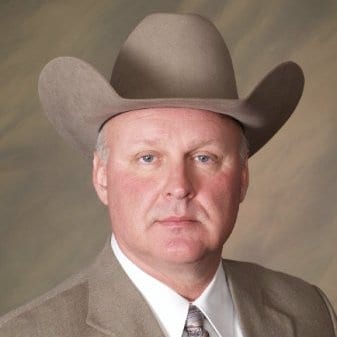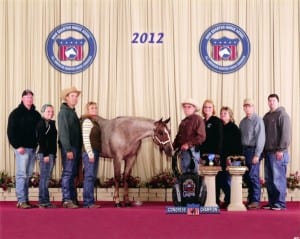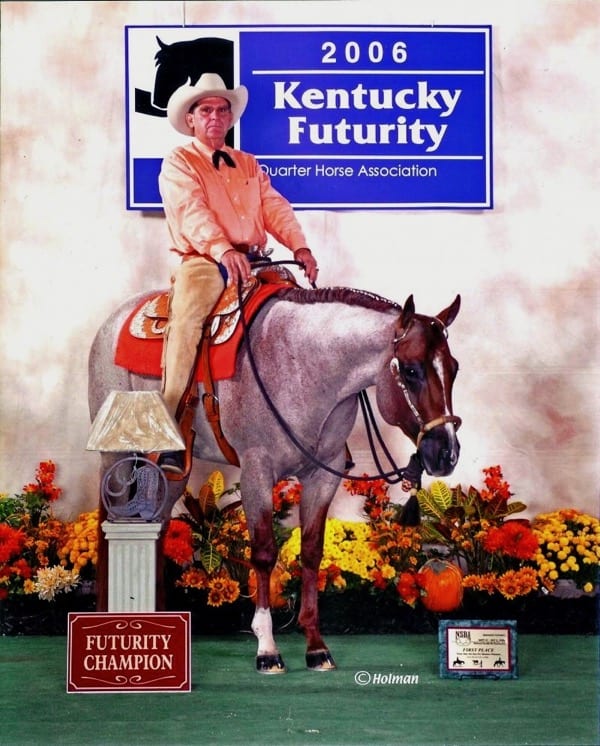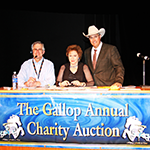There is an old, and very bad, saying about the cost of owning horses. Goes something like this, “If you want to make a million in the horse business, start with two million.”
While no one denies the cost of horse ownership can be expensive, horse owners are quick to say how horse ownership has enriched their lives, brought their families together, given their kids a sense of purpose and responsibility and a number of other accolades, while they happily continue to write the checks.
Still, the prospect of being able to earn back a bit of what they are investing in their nickering friends is an attractive one. That prospect has kept the Kentucky Quarter Horse Association and its Breeders Incentive Fund (BIF) on the radar of many American Quarter Horse owners, in and out of the state.
“It’s definitely made an impact on our program,” says Hawkesville, Ky., breeder Jerry Powers (pictured above). “We get about 20 mares a year that are from out of state and I get a number of phone calls from people who are looking for horses enrolled in the Kentucky incentive program, so it’s definitely made a difference.”
 The program, which launched in 2006, is enjoying a decade as one of the most successful incentive program, state or nationally managed, in the country. That success is due in great part, says Norm Luba (pictured right), a Kentucky AQHA Director, to the simplistic and inclusive nature of the program.
The program, which launched in 2006, is enjoying a decade as one of the most successful incentive program, state or nationally managed, in the country. That success is due in great part, says Norm Luba (pictured right), a Kentucky AQHA Director, to the simplistic and inclusive nature of the program.
“The fact that the program continues to attract horses and buyers to the state in what has been a declining horse economy is absolutely a testimony to its success,” he said. “What has made this program work is that anyone can buy a Kentucky-bred and show it wherever they want to, and earn money.”
Powers echos that sentiment. He and his wife, Shirley, stand a striking red roan stallion named Good To Know, sire of 2012 All American Quarter Horse Congress NSBA Non-Pro Western Yearling Longe Line Stakes Champion You Will Kno Im Good (pictured below).
“You have to have quality for people to want to buy your horses so we stand a nice stallion, but when a buyer knows you’re from Kentucky, finding out if your horse or your foals are enrolled in the incentive fund is always the next question,” he said. “Plus, since we breed about 20 out of state mares, those mares have to come back and foal in the state for their babies to be eligible. They can foal anywhere they want to in the state, but they all usually come back here and that is additional income for us.
“It’s really good for the entire state, because more feed is getting sold, more services are being needed, so more money is being made by more people.”
While some state incentive programs only allow points to count on shows within their states, Kentucky took “the show anywhere” approach that actually made administration much simpler and more logical.
 “To do otherwise is like telling someone who buys a Ford manufactured at the plant in Kentucky that they can only drive that Ford in the state of Kentucky,” he said. “That doesn’t incentivize anyone to buy a Kentucky bred when they live outside of the state.”
“To do otherwise is like telling someone who buys a Ford manufactured at the plant in Kentucky that they can only drive that Ford in the state of Kentucky,” he said. “That doesn’t incentivize anyone to buy a Kentucky bred when they live outside of the state.”
Since it’s launch in 2006, the Kentucky program has awarded more than $2.9 million, with enrollment growing from 615 show horses awarded to 1,189. In race horses, awards have been allocated to an average of about 60 horses per year, but that number should rise soon with a Quarter Horse racing venue constructed in Corbin that will feature year-round simulcasting of races from elsewhere and hundreds of historical racing terminals, similar to slot machines.
Unlike the state of Texas, which has thwarted any efforts by the Texas Racing Commission to install historical racing terminals at the state’s three tracks (a move highly supported by Texas horsemen for sorely needed funding of that state’s horse industry), Luba said legislators in Kentucky have been and remain highly supportive of the Kentucky Breeders Incentive Fund, even when that meant taxing the industry.
“They have always remained very supportive of the program,” he said. “Horses are obviously an important part of the economy in Kentucky but there was no hesitation to including breeds, non-racing breeds at that, other than Thoroughbreds in the program.”
Funding for the program comes from the six percent sales taxes generated on stud fees, regardless of breed, on stallions residing within the state. A million dollars from that fund is earmarked for ‘non-race’ breeds, which applies to most of the American Quarter Horse in Kentucky, who in turn represent about 90 percent of the non-race breeders in the state. In another move that seems contrary to other states, where racehorse and show horse folks rarely work together, monies collected are managed by the Kentucky Racing Commission under the watchful eye of Jamie Eads, Director of Incentives and Development.
“The six percent sales tax that is collected generates about $12-13 million a year and 80 percent of those funds goes back to the Thoroughbred industry because they are obviously the larger portion of the breeds in the state,” said Eads. “The money is split out among 13 participating breeds. Seven percent is collected for the non-race breeds, which includes Quarter Horses. Their portion of the pie is dependent on how many horses are in the state under the age of 25. This year the money is up a little bit and they should be receiving about $252,000 to distribute.”
When Eads started with the program in 2008, funding had actually dropped due to the recession and breeding had slowed, staying somewhat in that pattern. But she’s optimistic. “We’ve got just a little bit more money this year which I take as a really good sign because we have been pretty flat up until this year.”
Eads has done her homework with incentive funds, and follows other Thoroughbred incentive programs fairly close.
“As far as I know, we are the only state that acknowledges multiple non-racing breeds, like Hackneys, Paint, Saddlebred, Morgan, etc., and because Quarter Horses are the largest portion, I have kept track of the AQHA Incentive Fund and our point value has actually been higher than their incentive fund.
“I think we all recognize that all of the equine breeds need to be economically healthy for the state’s industry to grow and the Kentucky legislature’s foresight to include all the breeds was very smart. It really does work, with Quarter Horses especially because you don’t have to compete in Kentucky to earn the money.”
In 2008, show horses were awarded slightly more than $73 per point, while in 2014, the last year in which data was available; show horses were awarded just over $45 per point. Enrollment by show horses increased from 889 to 1,189. Racehorse point values increased over the same time period, with 2008 offering $68 a point and 2014 offering nearly $142. Racehorse enrollments have gone virtually unchanged with 58 enrolled in 2014.
“The Quarter Horses in the program have been a star for us,” said Eads. “They had a tremendous increase in the stallions that came here and in equine activity in general. There was a time after the recession where farm land was open and we saw that getting picked up by Quarter Horse community and I think it was in direct correlation to this program.”
Enrollment in the program, like its rules, is relatively straightforward. As a matter of fact, KyQHA put their goal to keep it simple in writing, “avoiding to the maximum extent possible the need for burdensome recordkeeping and administrative costs.” The BIF awards are based on points earned at AQHA horse shows, and for racehorses on racing points awarded according to conditions and order of finish for races recognized by the AQHA.
The BIF was specifically designed to stimulate demand for Kentucky-bred horses and not supply, which has driven the demand for those horses from out of state.
“I get phone calls regularly from people who are looking for Kentucky-bred horses and frankly, they’re hard to come by,” Luba said. “Before the legislation was even passed, our association put together a great group of forward thinking people and we developed what we thought would be a program that would continue to stimulate our economy and it has. We continue to believe and promote the idea the people who participate in sanctioned competitions invest more money and time in the industry than those who don’t. They’re more active in their associations and more politically active. Those are the people who are really being rewarded through this program.”
The Rules
Participation in the program requires some simple steps. First, all owners, breeders, and sire owners of BIF eligible horses are required to be members of the KyQHA as well as AQHA by July 1 each year, for points earned at competitions the previous year. For example, award winners must be members by July 1, 2016 for points earned in competitions during 2015. Then, stallions enrolled in the program have to take up residency within the state for the breeding season, while mares must be bred in the state and foal in the state. Mares, are not, however, required to remain in the state during their pregnancy.
“That allows mare owners to continue to show their mares during the early stages of pregnancy, as well as keep them at home and monitor their progress until the last weeks of the pregnancy,” said Luba. “The requirement has also had an economic effect as well, providing for a steady source of business to breeding farms and foaling facilities,”
Stallion owners who live in Kentucky are automatically eligible for stallion awards for point earning progeny conceived in that season while those who are not residents, and would like to be eligible, pay an annual fee equal to the current nomination fee by February 1 following each year in which points are earned.
There are fees to consider, including a $500 fee to be paid and submitted to KyQHA with the embryo transfer application, as well as a $50 fee member fee to be submitted with a foaling verification and registration form by December 31 of the foaling year. This fee is increased as the months go by, so it’s best to get it to the KyQHA on time. A $300 Stallion Nomination Fee is due at the KyQHA office post-marked no later than February 1 of the current breeding season each year. Fifty percent of those fees go to a number of BIF supplemental programs such as the KyQHA BIF Premium Series, an imaginative program that stimulates participating in AQHA shows conducted by the Kentucky Quarter Horse Association; rewarding sires of champions at the of the All American Quarter Horse Congress and the AQHA World Championship shows; and providing KyQHA BIF nominated sires even greater exposure through the KyQHA web site www.kyqha.com.
The “Sires of Champions” program rewards BIF stallions, nominated in years 2009 and later, that have sired a Congress AQHA Class Champion or an AQHA World Show Champion. Should the sire have been a part of the program since 2009, the owner will receive a pro-rated share of up to a $2,000 award when the stallion is the sire of a Congress Champion or an AQHA World Show Champion. If not, a percentage will be applied for the number of years the stallion has been a part of the program.
The “Stable Stallions” program rewards BIF stallions that have been nominated for a number of consecutive years, beginning with the current breeding season, with complimentary Web Site acknowledgements that can include, depending on the number of years of enrollment, attachments to the stallion’s listing of a Certificate of Registration in PDF format, a photograph of the stallion and an AQHA-generated performance record of “Foals of Stallion [Name]” in PDF format. Further, complimentary “For Sale” advertising on KyQHA web site for all horses by the stallion owned by the stallion nominator can also be included.
“These programs are key to our goal of incentivizing demand for Kentucky-bred horses,” said Luba. “When we were developing the program, we believed that the prices for Kentucky-bred horses would be driven by a program built on a sound economic plan for supply and demand. This program is certainly unique to Kentucky because someone can come to Kentucky, buy a Kentucky-bred and take that horse anywhere. We’ve even have Kentucky-breds in Europe.”
Although BIF horses are no longer required to be a part of the AQHA Incentive Fund, Luba encourages participation there as well.
“AQHA’s fund is paying a little more than $15 a point and with our allocation of nearly $45 a point, owners can earn as much as $60 per point,” he said, adding that those incentives clearly increase participation in showing and breeding. “We’ve seen nearly a doubling of Kentucky-breds that are competing in AQHA competition in a decade that has been very trying in the horse industry. So, I think our model is correct and working the way it was intended to work.”








